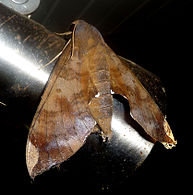| Fig sphinx | |
|---|---|

| |
| Queen Elizabeth II Botanic Park, Grand Cayman | |
| Scientific classification | |
| Domain: | Eukaryota |
| Kingdom: | Animalia |
| Phylum: | Arthropoda |
| Class: | Insecta |
| Order: | Lepidoptera |
| Family: | Sphingidae |
| Genus: | Pachylia |
| Species: | P. ficus |
| Binomial name | |
| Pachylia ficus (Linnaeus, 1758) | |
| Synonyms | |
| |
Pachylia ficus, known as the fig sphinx, is a moth of the family Sphingidae. It lives from the northern tip of South America in Uruguay through Central America to the southern tip of the United States straying into Arizona and Texas.
Description
It has a wingspan of 4+3⁄8–5+1⁄2 inches (110–140 mm), with orange-brown wings.
-
 Pachylia ficus male
Pachylia ficus male
Dorsal side MHNT -
 Pachylia ficus male
Pachylia ficus male
△ Ventral side MHNT -
 Pachylia ficus female
Pachylia ficus female
Dorsal side MHNT -
 Pachylia ficus female
Pachylia ficus female
△ Ventral side MHNT -

Biology
There are several generations per year in the tropics, peninsular Florida and southern Texas. Adults have been recorded in February, September and November in Brazil and in June in Panama. The adults feed on the nectar of various flowers, including Asystasia gangetica and the endangered ghost orchid (Dendrophylax lindenii). They also pollinate the ghost orchid.
The larvae have been recorded feeding on Ficus aurea, Ficus carica, Ficus microcarpa, Ficus religiosa, Ficus pumila, Ficus gamelleira, Ficus prinoides, Ficus pumila and Artocarpus integrifolius. There are several colour morphs. Pupation takes place in a cocoon spun amongst leaf litter.
References
- "CATE Creating a Taxonomic eScience - Sphingidae". Cate-sphingidae.org. Archived from the original on 2012-11-12. Retrieved 2011-10-19.
- "Silkmoths". Silkmoths.bizland.com. Archived from the original on 2016-03-04. Retrieved 2011-10-19.
- Main, Douglas (12 July 2019). "Discovery reveals secrets about how ghost orchids reproduce". National Geographic News. National Geographic Society. Archived from the original on February 18, 2021. Retrieved 23 March 2021.
- Houlihan, Peter R.; Stone, Mac; Clem, Shawn E.; Owen, Mike; Emmel, Thomas C. (December 2019). "Pollination ecology of the ghost orchid (Dendrophylax lindenii): A first description with new hypotheses for Darwin's orchids". Scientific Reports. 9 (1): 12850. doi:10.1038/s41598-019-49387-4. PMC 6731287.
External links
- Fig sphinx Moths of America
| Taxon identifiers | |
|---|---|
| Pachylia ficus | |
This Dilophonotini-related article is a stub. You can help Misplaced Pages by expanding it. |